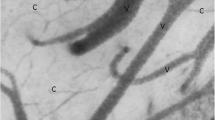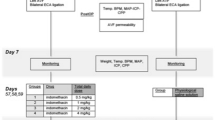Abstract
To assess the safety of retrograde cerebral perfusion, the occurrence of brain edema after this procedure was investigated. Twenty-eight adult mongrel dogs were divided into three groups that underwent the following treatments: antegrade perfusion (group 1, n=9); retrograde perfusion alone (group 2, n=11); or tetrograde perfusion with drugs (manuitol, thiopental sodium, and methylprednisolone; group 3, n=8). After 90 minutes of cerebral perfusion at 20°C of the pharyngeal temperature, evans blue (EB) was administered to check for disruptions of the blood-brain-barrier (BBB) and brain tissue water content was measured. Intracranial pressure after cerebral perfusion was markedly higher in group 2 than in group 1 (26.4 ± 9.4 vs. 11.2 ± 3.6 mmHg), and brain tissue water content was also significantly higher in group 2 than in group 1 (80.7 ± 2.0 vs. 77.8 ± 0.9%). these data suggested that brain edema was more prominent after retrograde perfusion than after antegrade perfusion. The extent of EB to brain tissue was greater in group 2 than in group 1 (169.8 ± 97.7 vs. 54.7 ± 31.5 μg/dl). The BBB was highly disrupted in group 2 and vasogenic edema appeared after retrograde cerebral perfusion. Maximum intracranial pressure, brain tissue water content and EB concentration were significantly lower in group 3 than in group 2, and did not differ significantly between group 3 and 1. Administration of pharmacologic agents suppressed edema formation and extravasation of EB. We conclude that 90 minutes of retrograde cerebral perfusion at 20°C of the pharyngeal temperature causes brain edema and disrupts the BBB in a manner different from that associated with antegrade perfusion. Mannitol, thiopental sodium, and methylprednisolone prevent these phenomena, indicating that pharmacologic intervention may improve the safety of retrograde cerebral perfusion.
Similar content being viewed by others
References
Usui A, Abe T, Murase M: Early clinical results of retrograde cerebral perfusion for aortic arch operations in Japan. Ann Thorac Surg 62: 94–104, 1996
Lemole GM, Strong MD, Spagna PM, Karmilowicz NP: Improved results for dissecting aneurysms. Intraluminal sutureless prosthesis. J Thorac Cardiovasc Surg 83: 249–255, 1982
Ueda Y, Miki S, Kusuhara K, Okita Y, Tahata T, Yamanaka K: Surgical treatment of aneurysm or dissection involving the ascending aorta and aortic arch, utilizing circulatory arrest and retrograde cerebral perfusion. J Cardiovasc Surg (Torino) 31: 553–8, 1990
20: 385–387, 1991
41: 2086–2092, 1993
41: 559–568, 1993
spectroscopy instrument (Invos 3100). 43: 1919–1923, 1995
Safi HJ, Iliopoulos DC, Gopinath SP, Hess KR, Asimacopoulos PJ, Bartoli S, Raskin SA, Shaibani AT, Leveque CM, Yawn DH: Retrograde cerebral perfusion during profound hypothermia and circulatory arrest in pigs. Ann Tcorac Surg 59: 1107–1112, 1995
Yasuura K, Ogawa Y, Okamoto H, Asakura T, Hoshino M, Sawazaki M, Matsuura A, Maseki T, Abe T: Clinical application of total body retrograde perfution to operation for aortic dissection. Ann Thorac Surg 53: 655–658, 1992
60: 449–458, 1991
Usui A, Hotta T, Hiroura M, Murase M, Maeda M, Koyama T, Tanaka M, Takeuchi E, Yasuura K, Watanabe T, Abe T: Retrograde cerebral perfusion through a superior vena caval cannula protects the brain. Ann Thorac Surg 53: 47–53, 1992
35: 145–151, 1995
46: 690–693, 1993
Bavaria JE, Pochettino A: Retrograde cerebral perfusion (RCP) in aortic arch surgery: Efficacy and possible mechanisms of brain protection. Semin Thorac Cardiovasc Surg 9: 222–232, 1997
Klatzo I: Neuropathological aspect of brain edema. J Neuropath Exp Neurol 26: 1–15, 1967
Robichaud LJ, Marcoux FW: Cold injury, Blood-Brain-Barrier changes, and leukocyte synthesis. Inhibition by Phenidone. J Neurotrauma 7 193–206, 1990
103: 199–207, 1991
Weissman DE, Grossman SA: A model for quantitation of peritumoral brain edema. J Neurosci Methods 23: 207–210, 1988
59: 62–65, 1992
Patten BM, Mendell J, Bruun B, Curtin W, Carter S: Double-blind study of the effects of dexamethasone on acute stroke. Neurology 22: 377–383, 1972
(CG-A30). 26: 1791–1815, 1977
6: 1–8, 1984
Drayer JIM, Weber MA, Purdy RE, Lipson JL: The effect of steroid hormones on vascular tissue. J Cardiovasc Pharmacol 6: 394–400, 1984
Yoshimura N, Okada M, Ota T, Nohara H: Pharmacologic intervention for ischemic brain edema after retrograde cerebral perfusion. J Thorac Cardiovasc Surg 109: 1173–1181, 1995
Author information
Authors and Affiliations
Rights and permissions
About this article
Cite this article
Tsuru, Y. An experimental study on the occurrence of brain edema after retrograde cerebral perfusion. Jpn J Thorac Caridovasc Surg 46, 992–999 (1998). https://doi.org/10.1007/BF03217861
Received:
Accepted:
Issue Date:
DOI: https://doi.org/10.1007/BF03217861




